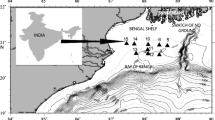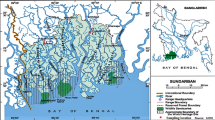Abstract
Three sediment cores were collected from different regions of the mangrove adjacent to Carmen Island, in Terminos Lagoon, to examine the influence that natural processes, the oil industry and urban development exert upon the mangrove environment. Textural and chemical characteristics were evaluated in each core. The variations among them reflect the different dynamic and depositional conditions for each site. Core C1, located near Puerto Real inlet, presents higher averages of grave l (16%), silt (32.6%), clay (1.48%), organic carbon (4.42%), carbonates (49.9%), CaO (28.96%), MgO (1.7%), P2O5 (0.99%) and Cu (4.46 mg/kg), some of these elements linked to the abundance of organisms in the area. Located in a channel with high sand content formed by an ancient delta, core C2 presents the highest average concentration of Al2O3 (4.39%), Fe2O3 (1.1%), MnO (0.02%), TiO2 (0.17%), Zn (14.8 mg/kg), Ni (16.9 mg/kg), Cr (293 mg/kg), V (12.3 mg/kg) and Cd (0.14 mg/kg), indicating high concentration of terrigenous sediments associated with heavy minerals. Situated in the lagoon border close to Carmen City, core C3 presents the highest sand (88.3%), SiO2 (64.5%), K2O (1.1%) and Pb (2.2 mg/kg) concentration. The location of this core makes it more susceptible to the dynamic processes that take place in the lagoon. The chemical differences observed in C2 are linked to the construction of Federal Highway 180. The drought that affected the basin during El Niño (1997–1998) produced a decrease in the rivers flow and a diminution of terrigenous sediments supply to Terminos Lagoon that is mainly observed in C3.








Similar content being viewed by others
References
Abel DC, McConnell RL (2010) Environmental oceanography: topics and analysis. Jones and Bartlett Publishers, Burlington
Bayen S (2012) Occurrence, bioavailability and toxic effects of trace metals and organic contaminants in mangrove ecosystems: a review. Environ Int 48:84–101
Benitez JA, Vidal J, Brichieri-Colombi T, Delgado-Estrella A (2012) Monitoring ecosystem health of the Terminos Lagoon region using heavy metals as environmental indicators. Environ Impact 162:349–358
Birth G (2003) A scheme for assessing human impacts on coastal aquatic environments using sediments. In: Woodcoffe CD, Furness RA (eds) Coastal GIS. Wollongong University Papers in Center for Maritime Policy 14 Australia, Wollongong
Bostrom K (1973) The origin and fate of ferromagnesian captive ridge sediments. Stockh Contrib Geol 27:149–243
Buchman MF (2008) NOAA screening quick reference tables. NOAA, OR&R Report 08-1, Seattle WA, Office of Response and Restoration Division, National Oceanic and Atmospheric Administration, p 34
Caeiro S, Costa MH, Ramos TB, Fernandez F, Silveira N, Coimbra A, Medeiros G, Painho M (2005) Assessing heavy metal contamination in Sado Estuary sediment: an index analysis approach. Ecol Indic 5:151–169
Carranza-Edwards A (2001) Grain size and sorting in modern beach sands. J Coast Res 17(1):38–52
Castellanos TL (1984) La costra de cromo en los estados de Tabasco y Campeche, México. Anales del Instituto de Ciencias del Mar y Limnologia. From http://biblioweb.tic.unam.mx/cienciasdelmar/instituto/1986-1/articulo199.html. 29 Apr 2016
Celis-Hernández O, Rosales-Hoz L, Carranza-Edwards A (2013) Heavy metal enrichment in surface sediments from the SW Gulf of Mexico. Environ Monit Assess 185(12):8891–8907
CONANP (2012) Laguna de Términos Área de Protección de Flora y Fauna, Campeche, México. From http://lagunadeterminos.conanp.gob.mx/cuerpo%20ubicacion.htm. 2 Jan 2015
Davis M, Masten S (2005) Ingeniería y Ciencias Ambientales. McGraw-Hill, Mexico
Day JW Jr, Conner WH, Ley-Lou F, Day RH, Machado-Navarro A (1987) The productivity and composition of mangrove forests, Laguna de Terminos, México. Aquat Bot 27:267–284
Dehgani M, Karbassi A (2015) Determining environmental sensitivity of mangrove forest at Hara protected area. J Biodivers Environ Sci 6(1):480–488
Dorantes VH (1988) Estudio del Sistema del dióxido de carbón en la Laguna de Terminos, Campeche durante las diferentes estaciones del año. Tesis Profesional, Facultad de Química
Fernández-Cadena JC, Andrade S, Silva-Coello CL, De La Iglesia R (2014) Heavy metal concentration in mangrove sediments from the north-west coast of South America. Mar Pollut Bull 82:221–226
Garduño-Ruiz EP, Rosales-Hoz L, Carranza-Edwards A (2016) Dissolved copper, nickel and lead in Tampamachoco Lagoon and Tuxpan River Estuary in the SW Gulf of Mexico. Bull Environ Contam Toxicol 97:490–496
Gaudette HE, Flight WR, Toner L, Folger DW (1974) An inexpensive titration method for the determination of organic carbon in recent sediments. J Sedimentol Petrol 44:249–253
Hesse PR (1971) A textbook of soil chemical analysis. Chemical Pub, New York
IIE (Instituto de Investigaciones Eléctricas) (1998) Boletín IIE mayo-junio/1998. From http://iie.org.mx/publica/bolmj98/secmj98.htm. 11 May 2016
INE (Instituto Nacional de Ecología) (1997) Programa de Manejo del Área de Protección de Flora y Fauna “Laguna de Términos”. INE, México
INEGI (Instituto Nacional de Estadística y Geografía) (2013) Anuario Estadístico de Campeche 2012. INEGI, México, p 400
Instituto de Comunicación Social del Estado de Chiapas (2015) Monitoreo y medidas preventivas ante efectos del fenómeno “El Niño” en Chiapas. In http://www.icosochiapas.gob.mx72015/09/03/monitoreo-y-medidas-preventivas-ante-efectos-del-fenomeno-el-niño-enchiapas/. 15 May 2016
Kasper-Zubillaga JJ, Arellano-Torres E, Armstrong-Altrin JS, Sial AN (2016) A study of carbonate beach sands from the Yucatan Peninsula, Mexico: a case study. Carbonates Evaporites 32(1):1–12
Loring DH, Rantala RRT (1992) Manual for the geochemical analysis of marine sediments and suspended particulate matter. Earth Sci Rev 32:235–283
Lynch JC, Meriwether JR, McKee BA, Vera-Herrera F, Twilley RR (1989) Marsh and mangrove responses to changes in sea level and sediment inputs. Estuaries 12(4):284–299
Magallanes-Ordóñez VR, Marmolejo-Rodríguez AJ, Rodríguez-Figueroa GM, Sánchez-González A, Aguíñiga-García S, Arreguín-Sánchez F, Zetina-Rejón M, Tripp-Valdez A, Romo-Ríos JA (2014) Characterization of lithogenic and biogenic zones and natural enrichment of nickel in sediments of the Terminos Lagoon, Campeche, Mexico. Estuar Shelf Sci 156:116–123
Merian E (1991) Metals and their compounds in the environment. VCH, Weinheim
NOAA (2016) NOAA incident news. From http://incidentnews.noaa.gov/incident/6250. 20 Apr 2016
NOAA-National Hurricane Center (2012) 1995 Atlantic hurricane season. From http://www.nhc.noaa.gov/data/tcr/AL191995_Roxanne.pdf. 3 Aug 2016
NOAA-National Hurricane Center (2014) 1995 Atlantic hurricane season. From http://www.nhc.noaa.gov/data/tcr/AL171995_Opal.pdf. 3 Aug 2016
Ortiz-Hernández LE, Escamilla-Casas JS, Flores-Castro K, Ramirez-Cardona M, Acevedo-Sandoval O (2006) Características geológicas y potencial metalogenético de los principales complejos ultramáficos-máficos de México. Boletín de la Sociedad Geológica Mexicana Tomo LVII 4:161–181
Palacio Prieto JL, Ortíz Pérez MA, Garrido Pérez A (1999) Cambios morfológicos costeros en Isla del Carmen, Campeche, por el paso del huracán “Roxanne”. Investig Geogr 40:48–57. From http://www.scielo.org.mx/scielo.php?script=sci_arttext&pid=S018846111999000300004&lng=es&tlng=es. 2 Aug 2016
Parvaresh H, Abedi Z, Farshchi P, Karami M, Khorasani N, Karbassi A (2011) Bioavalability and concentration of heavy metals in the sediments and leaves of grey mangrove, Avicennia marina (Forsk.) Vierh, in Sirik Azini Creek, Iran. Biol Trace Elem Res 143:1121–1130
Praveena SM, Ahmed A, Radojevic M, Abdullah MH, Aris AZ (2008) Heavy metals in mangrove surface sediment of Mengkabong Lagoon, Sabah: multivariate and geo-accumulation index approaches. Int J Environ Res 2(2):139–148
Rosales-Hoz L, Carranza-Edwards A, Mendez-Jaime C, Monreal-Gómez MA (1999) Metals in shelf sediments and their association with continental discharges in a tropical zone. Mar Freshw Res 50:189–196
Ruiz-Fernandez AC, Maanban M, Sanchez-Cabeza JA, Perez-Bernal LH, López-Mendoza P, Limoges A (2014) Cronología de la sedimentación reciente y caracterización geoquímica de los sedimentos de la Laguna de Alvarado, Veracruz (suroeste del Golfo de México). Cienc Mar 40(4):291–303
Sany TSB, Salleh A, Rezayi M, Narimany L, Tehrani GM (2013) Distribution and contamination of heavy metals in the coastal sediments of Port Klang, Selangor, Malaysia. Water Air Soil Pollut 224:1476–1482
SEMAR (Secretaría de Marina. Dirección General de Investigación y Desarrollo) (2006) Carta S.M. 800 Tampico a Progreso. 5/a ed
Soto Jiménez MF, Paez-Osuna F (2001) Distribution and normalization of heavy metal concentration in mangrove and lagoonal sediments from Mazatlan Harbor (SE Gulf of California) Estuar. Coast Shelf 53:259–274
Taylor SR, McLennan SM (1985) The continental crust: its composition and evolution. Blackwell, Oxford
Wakida-Kusunoki A, Caballero-Chávez V (2009) Efectos del derrame de hidrocarburos del Pozo Kab sobre la pesca ribereña en el litoral de Campeche y Tabasco, México. Cienc Pesq 17(1):65–73
Yang Y, Liu Z, Chen F, Wu S, Zhang L, Kang M, Li J (2014) Assessment of trace element contamination in sediment cores from the pearl river and estuary, South China: geochemical and multivariate analysis approaches. Environ Monit Assess 186:8089–8107
Acknowledgements
Special thanks to S. Santiago-Pérez, E. Morales de la Garza and Ricardo Martínez for technical assistance in sample analysis and to the Consejo Nacional de Ciencia y Tecnología (CONACYT) for funding through scholarship program Nos. 209683/202662.
Author information
Authors and Affiliations
Corresponding author
Rights and permissions
About this article
Cite this article
Madrid, H.C., Rosales Hoz, L., Márquez García, A.Z. et al. Environmental assessment of a mangrove protected area in the southeast Gulf of Mexico through sediment core analysis. Environ Earth Sci 77, 73 (2018). https://doi.org/10.1007/s12665-017-7160-1
Received:
Accepted:
Published:
DOI: https://doi.org/10.1007/s12665-017-7160-1




